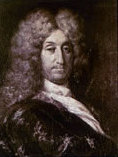William Craven, 1st Earl of Craven (1608–1697) facts for kids
William Craven, 1st Earl of Craven (born June 1608 – died 9 April 1697) was an important English nobleman and soldier. He was also a member of the Privy Council, a group of advisors to the King or Queen.
Contents
Early Life and Family Background
William Craven was born in 1608. His father, also named William Craven, came from a poor family in Appletreewick in North Yorkshire. He moved to London and became very successful and rich. He even became the Lord Mayor of London in 1610.
William's mother was Elizabeth Whitmore. Her brother, George Whitmore, also became a Lord Mayor of London later on. William had several brothers and sisters, including John Craven, 1st Baron Craven of Ryton. His sisters Mary and Elizabeth married into important noble families.
Education and Early Career
In 1623, when he was about 15 years old, William Craven started studying at Trinity College, Oxford. He later earned a Master of Arts degree in 1636.
A Soldier's Life in Europe
William Craven was a brave soldier. He fought in the Thirty Years' War in Europe. This was a very long and big war that involved many countries.
Fighting for Frederick V
Craven fought for Frederick V, who was a king in Europe. In March 1632, during a battle at Bad Kreuznach, he showed great courage. The famous King Gustavus Adolphus of Sweden even praised him for his bravery. Craven was also seriously hurt in this battle.
In October 1638, at the Battle of Vlotho Bridge, he was captured by the enemy. He was later set free after a large sum of money, £20,000, was paid for him.
Devotion to Elizabeth of Bohemia
William Craven also fell in love with Queen Elizabeth of Bohemia. She was a British princess. During the English Civil War, Craven was not in England. Instead of fighting, he helped Elizabeth's brother, King Charles I, by giving him money.
Because he supported the King, his lands in England were taken away. These lands included his main home, Caversham Park in Oxfordshire. After the King was restored to power, Craven planned to build a huge palace for Elizabeth. However, she died before the palace could be built. William Craven never married, perhaps because of his strong feelings for Queen Elizabeth.
Life After the Restoration
After the King was back on the throne, William Craven was given many important jobs in the royal court. He was also made an Earl, which is a high noble title.
Role in the Colonies
He was given a share in the Colony of Carolina in America and was one of its Lords Proprietors, meaning he helped govern it. Craven County in North Carolina is named after him.
Public Service in London
As a member of the Privy Council, he worked hard. He often attended meetings about important matters, like trade and fishing. In 1678, he was present at a very important meeting where Titus Oates first talked about the Popish Plot, a false story about a Catholic plan against the King.
Helping During the Great Plague
William Craven earned the respect of the people of London during the terrible Great Plague of 1665. Many rich people fled the city to escape the sickness, but Craven stayed. He helped keep order and even gave some of his land to be used as burial grounds for those who died. This showed his great care for the people.
The Glorious Revolution
In December 1688, during a time called the Glorious Revolution, William Craven was the colonel of the Coldstream Guards, a group of soldiers. He was protecting King James II at Whitehall Palace.
When soldiers loyal to the Prince of Orange came to take over the palace, Craven swore he would fight to the end. But King James II told him to stand down, and Craven obeyed.
Later Years and Legacy
William Craven died in London on 9 April 1697. He was 88 years old. He is remembered as a brave soldier, a loyal supporter of the King, and a kind nobleman who helped the people of London during a difficult time.
Images for kids




